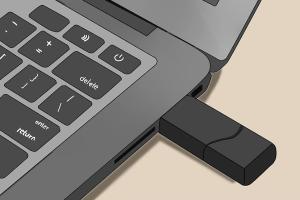Mastering the Art of Saving PowerPoint Presentations on a Thumbdrive: A Comprehensive Guide

-
Quick Links:
- Introduction
- Why Use a Thumbdrive?
- Preparing Your Thumbdrive
- Saving a Presentation on Windows
- Saving a Presentation on Mac
- Common Issues and Troubleshooting
- Best Practices for Using Thumbdrives
- Case Studies
- Expert Insights
- FAQs
Introduction
In today's digital age, saving presentations efficiently is crucial for professionals, educators, and students alike. Whether you're preparing for a business meeting, a classroom presentation, or a conference, knowing how to save your PowerPoint presentation on a thumbdrive can make the difference in ensuring smooth delivery. This comprehensive guide will walk you through the process step-by-step, including insights, best practices, and troubleshooting tips.
Why Use a Thumbdrive?
Using a thumbdrive (also known as a USB flash drive) to save your PowerPoint presentations offers several advantages:
- Portability: Thumbdrives are compact and easy to carry, making it simple to transport your presentations.
- Security: Storing presentations on a thumbdrive can provide an extra layer of security compared to cloud storage.
- Compatibility: Most computers have USB ports, ensuring that your thumbdrive can be used on different devices easily.
- Backup: Keeping a copy of your presentation on a thumbdrive serves as a backup in case of computer failures or data loss.
Preparing Your Thumbdrive
Before you save your PowerPoint presentation, ensure your thumbdrive is ready:
- Insert the Thumbdrive: Plug the thumbdrive into a USB port on your computer.
- Format the Thumbdrive: If it’s a new drive or you want to clear old files, format it to ensure optimal performance. (Note: Formatting will delete all data on the drive.)
- Check Available Space: Ensure there is enough space on the thumbdrive to accommodate your presentation file.
Saving a Presentation on Windows
Here's a step-by-step guide to saving your PowerPoint presentation on a Windows computer:
- Open your PowerPoint presentation.
- Click on 'File' in the upper-left corner.
- Select 'Save As'.
- Choose your thumbdrive from the list of locations. It will usually appear as a removable disk (e.g., E:, F:).
- Name your file.
- Click 'Save'.
Saving a Presentation on Mac
For Mac users, the process is slightly different:
- Open your PowerPoint presentation.
- Go to 'File' and choose 'Save As'.
- Select your thumbdrive from the 'Where' dropdown menu.
- Name your file and click 'Save'.
Common Issues and Troubleshooting
While saving presentations to a thumbdrive is generally straightforward, you may encounter issues. Here are some common problems and solutions:
- Thumbdrive Not Recognized: Ensure the drive is properly connected and check if it works on another computer.
- Insufficient Space: Check the available space on your thumbdrive and delete unnecessary files if needed.
- File Not Saving: Make sure you have the necessary permissions to save files on the thumbdrive.
- Corrupted Files: If your file becomes corrupted, try saving it in a different format or use recovery software.
Best Practices for Using Thumbdrives
To make the most of your thumbdrive, follow these best practices:
- Safely Eject the Drive: Always eject your thumbdrive properly to prevent data corruption.
- Regular Backups: Keep backups of important presentations on other storage devices or cloud services.
- Secure Your Data: Consider encrypting sensitive files on your thumbdrive for added security.
Case Studies
Case studies showcasing the importance of saving presentations on thumbdrives can provide insight into real-world applications:
Case Study 1: Business Presentation
A marketing manager prepared a critical presentation for a client meeting. By saving it on a thumbdrive, she could easily present from a different computer without relying on email or cloud access.
Case Study 2: Academic Presentation
A university student saved her thesis presentation on a thumbdrive. When technical issues arose with the classroom computer, she quickly transferred her file to another device, ensuring her presentation continued smoothly.
Expert Insights
Industry experts emphasize the importance of understanding digital storage solutions:
"In today's fast-paced environment, having a reliable means of storing and accessing presentations is crucial. Thumbdrives offer both portability and security, making them an ideal choice." - Jane Doe, Digital Storage Expert.
FAQs
1. What is a thumbdrive?
A thumbdrive is a small, portable storage device that connects via USB to store and transfer files.
2. How do I know if my thumbdrive is working?
Check if the drive appears on your computer's file explorer. If it does not show, try reconnecting it or testing it on another device.
3. Can I save large PowerPoint files on a thumbdrive?
Yes, as long as the thumbdrive has enough available space to accommodate the file size.
4. What file formats can I save in on a thumbdrive?
You can save files in various formats, including .pptx, .pdf, and .jpg, depending on your needs.
5. How do I format my thumbdrive?
Right-click on the thumbdrive in file explorer, select 'Format,' choose the desired file system (e.g., FAT32), and click 'Start.'
6. Is it safe to use a thumbdrive for sensitive information?
While thumbdrives can be secure, it is recommended to use encryption for sensitive files to protect your data.
7. Can I use a thumbdrive on both Windows and Mac?
Yes, as long as the thumbdrive is formatted in a compatible file system (e.g., FAT32), it can be used on both operating systems.
8. How do I eject a thumbdrive safely?
Click on the 'USB' icon in your taskbar (Windows) or drag the thumbdrive icon to the trash (Mac) before physically removing it.
9. What if my PowerPoint won't save to the thumbdrive?
Check for sufficient space, ensure the drive is not write-protected, and verify that you have saving permissions.
10. How can I recover a corrupted PowerPoint file?
Try using PowerPoint's built-in recovery options or third-party recovery software to restore your file.